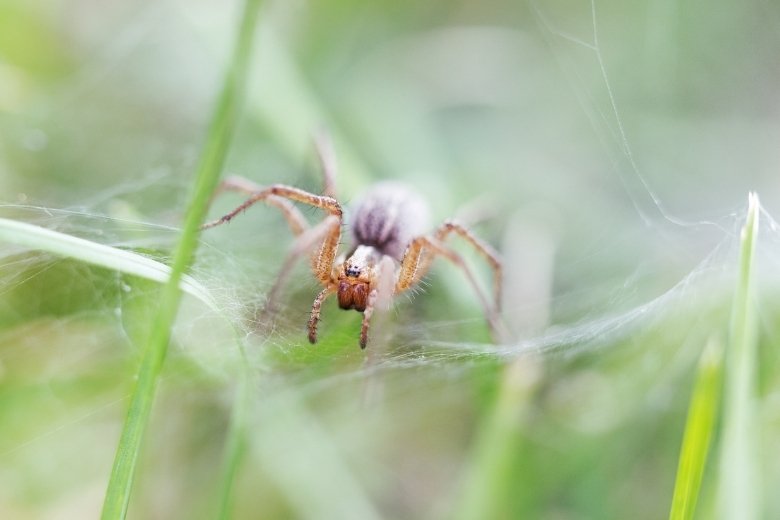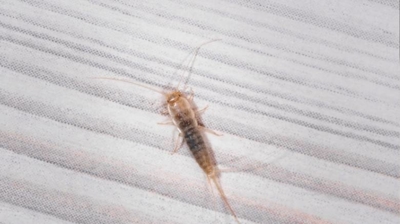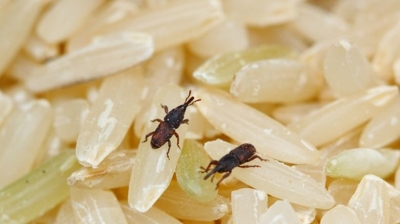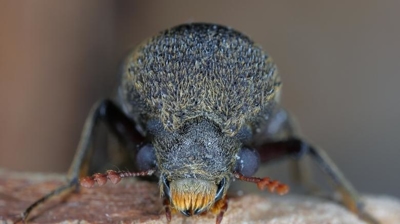
Grass Spider Control Services

Are Grass Spiders Harmful?
Grass spiders (genus Agelenopsis) are generally not considered harmful to humans, but there are a few aspects in which they might be perceived as harmful, especially from the standpoint of homeowners, or those with arachnophobia:
- Venom and Bites (Rare but Possible): Grass spiders are venomous—as are almost all spiders—but their venom is not considered medically significant to humans. They are timid and non-aggressive, preferring to flee rather than bite. However, under certain conditions (e.g., if they are trapped against the skin), they may bite in self-defense.
- Psychological Impact: Especially to individuals with arachnophobia, the presence of grass spiders can be distressing. Their speed and sudden movements, combined with the appearance of their funnel-shaped webs, can trigger fear and anxiety, especially indoors. Their sheet-like webs in the grass or near foundations and shrubs can cause unease, especially when they appear in high numbers. Though they prefer the outdoors, they occasionally wander into homes, which can be unsettling for residents.
- Proliferation Near Structures: In certain environments, grass spider populations can flourish near buildings, especially in areas with thick vegetation or poorly maintained landscaping. While they do not infest structures like cockroaches or ants, their presence can give the impression of a spider “infestation.”
- Aesthetic and Maintenance Issues: Grass spiders can build their characteristic funnel-shaped webs in turfgrass, ornamental plants, shrubs, and corners of structures. While these webs are not damaging, they can be unsightly and accumulate quickly in warm months. Homes or businesses with multiple visible webs may appear unkempt or neglected. In lawns and landscaped areas, the webs can temporarily impact curb appeal.
Learn more: Do Grass Spiders Bite?
Learn more: Are Grass Spiders Venomous?
Grass Spider Control
Hiring our professional pest control for grass spiders is advisable for several reasons, particularly if you have a large property, an infestation, or if you simply want a long-term solution to these spiders:
- Expert Identification: Grass spiders are often confused with other spiders, including potentially more harmful species. Our professionals can correctly identify the species in your yard and determine whether they are purely a nuisance or could pose a risk to pets, children, or the structure of your home. Misidentifying spiders can lead to ineffective or unnecessary treatments.
- Targeted Treatment Plans: Our professionals have access to specialized insecticides and integrated pest management (IPM) strategies that are both effective and safe for the environment. We know which products work best for grass spiders without harming beneficial insects, pollinators, or your lawn. DIY sprays often only provide temporary relief and may not reach the spiders’ hidden retreats or egg sacs.
- Prevention of Reinfestation: Grass spiders build webs and lay eggs in grass and shrubs, which can lead to recurring problems. Our professionals not only treat the existing population but also implement preventive strategies such as removing debris and thick vegetation where spiders hide, applying barrier treatments around structures, and advising on landscaping changes to reduce spider-friendly habitats.
- Safety Considerations: While grass spiders are generally not dangerous to humans, handling insecticides improperly or disturbing spider nests can still pose a health risk. Our professionals are trained in safe application techniques, protective gear, and the correct dosages to minimize any potential hazards.
- Long-Term Cost Efficiency: Hiring our professionals often saves money in the long run. DIY methods may require repeated treatments, and ineffective measures can lead to a growing infestation that is harder and more costly to control over time.
- Peace of Mind: Having our professionals assess and treat your property removes the stress of dealing with unknown infestations. You’ll have a clear understanding of the problem, the treatment plan, and the expected outcomes, rather than guessing if your home or yard is truly spider-free.
Grass spiders might seem harmless, but our professional approach ensures accurate identification, effective elimination, preventive strategies, and safety for your family and pets. It’s about creating a healthy, spider-managed environment rather than a temporary fix.
Learn more: How To Get Rid Of Grass Spiders
What Do Grass Spiders Look Like?
Grass spiders, belonging to the genus Agelenopsis, exhibit several physical characteristics that help distinguish them from other spider species. Here is a detailed description of what grass spiders typically look like:
- Size: Grass spiders are generally small to medium-sized spiders. They have a body length that ranges from approximately 1/4 to 3/4 inch (6 to 19 mm) and a leg span that can be up to 1.5 inches (38 mm), depending on the species and gender.
- Body Shape: Their bodies are elongated and slender, with a slightly flattened appearance. The cephalothorax (the front part of the body, where the legs are attached) is slightly wider than the abdomen, and they have a distinct waist-like constriction.
- Color: Grass spiders can vary in color but are typically shades of light brown, gray, or tan. Some individuals may have subtle patterns or markings on their bodies, but they lack the bold, distinctive markings seen in some other spider species.
- Legs: They have eight long and thin legs that are covered in fine hairs. The legs are often banded or striped with darker and lighter segments. These long legs are adapted for running and web-building.
- Eyes: Grass spiders typically have eight small eyes arranged in two horizontal rows. Their vision is not particularly acute, and they rely more on vibrations and touch to detect prey and threats.
- Spinnerets: At the rear of their abdomen, grass spiders have two prominent spinnerets, which they use to produce silk for constructing their webs.
- Palps: Male grass spiders have modified pedipalps, which are located near the mouthparts and are used during mating. These palps can be used to help identify the gender of the spider.
- Abdomen: The abdomen of grass spiders is usually cylindrical or oval-shaped and lacks any distinct markings or patterns. It may be slightly pointed at the rear end.
- Web: While not a physical characteristic of the spider itself, the web they construct is a key identifier. Grass spiders build flat, sheet-like webs with a funnel-shaped retreat at one end. This retreat is where the spider hides and waits for prey to become ensnared in the web.
There are several species within the Agelenopsis genus, and there can be variation in their appearance. Additionally, young grass spiders (spiderlings) may look different from adults. However, the general characteristics described above should help in identifying grass spiders in their natural habitats.
Where Are Grass Spiders Found?
Grass spiders, belonging to the genus Agelenopsis, are commonly found in North America and are known for their preference for grassy and open habitats. Here's a detailed description of where you might typically find grass spiders:
- Grassy Areas: As their name suggests, grass spiders are often found in grassy areas such as meadows, fields, lawns, and pastures. They are well adapted to these environments and are frequently encountered in such locations.
- Gardens: Grass spiders can also be found in gardens, particularly in areas with tall grasses, shrubs, or low-lying vegetation. They construct their funnel-shaped webs near the ground among plants.
- Forest Edges: In wooded areas, you may find grass spiders near the edges of forests or in clearings where there is ample vegetation. They are less common in dense, deep forest interiors.
- Wetlands: Some species of grass spiders are adapted to wetland habitats, including marshes and swampy areas. They can be found in these environments, especially along the edges where vegetation is abundant.
- Human Structures: Grass spiders are known to occasionally inhabit man-made structures like sheds, barns, and outdoor structures like playsets or swing sets. They may construct their webs in sheltered areas where insects are likely to be present.
- Under Rocks and Debris: In addition to their funnel-shaped webs, grass spiders may take shelter under rocks, logs, or other debris during the day. They use these retreats as hiding places when not actively hunting.
- Urban and Suburban Areas: Grass spiders can be found in urban and suburban environments, particularly in green spaces, parks, and residential lawns. They often coexist with humans in these areas, helping to control insect populations.
- Geographic Range: The specific species of grass spiders you encounter can vary depending on your geographic location. Different species have different ranges and habitats. Some are more common in certain regions than others.
Grass spiders are generally not aggressive towards humans and are not considered medically significant. They play a beneficial role in controlling insect populations and are a common and natural part of many outdoor ecosystems. If you're interested in observing or studying grass spiders, you can start by exploring the above-mentioned habitats, especially during the warmer months when they are most active.
What Do Grass Spiders Eat?
Grass spiders, like many other spider species, are primarily carnivorous and feed on a diet consisting of various small arthropods and insects. Here is an overview of what grass spiders typically eat:
- Insects: Grass spiders are skilled hunters that primarily prey on insects. They construct funnel-shaped webs close to the ground, where they wait for unsuspecting insects to land on or fly into their webs. When an insect becomes ensnared, the spider quickly rushes out to immobilize and bite its prey.
- Flying Insects: Grass spiders capture a wide range of flying insects that get caught in their webs, including flies, mosquitoes, moths, and various types of beetles.
- Ground-Dwelling Insects: These spiders also target ground-dwelling insects such as ants, grasshoppers, crickets, and other small arthropods that crawl into their webs or come into close proximity.
- Spiders: While grass spiders primarily feed on insects, they have been known to cannibalize other spiders, especially smaller or weaker ones that inadvertently enter their webs.
- Non-Insect Prey: On occasion, grass spiders may capture and consume non-insect prey, such as small arachnids or even small prey like woodlice, which are not insects but are still suitable as a food source.
- Feeding Behavior: Grass spiders inject their prey with venom to immobilize and digest them. They then use their silk to wrap the immobilized prey in a cocoon, which helps break down the prey's internal tissues and makes it easier for the spider to feed. Once the prey is sufficiently liquefied, the spider sucks out the nutrients.
- Web Maintenance: In addition to capturing prey, grass spiders also periodically eat their own web silk. This recycling of silk ensures that the spider can continue to produce new silk for web construction.
- Occasional Vegetation: While grass spiders are primarily carnivorous, there is some evidence that they may occasionally consume plant material, such as pollen or nectar. However, this behavior is not well-documented and is relatively rare.
Grass spiders are effective predators of insects and other small arthropods in their habitats. They play a valuable ecological role by helping to control insect populations, which contributes to the balance of local ecosystems.
Grass Spider Life Cycle
The life cycle of grass spiders, like many spider species, typically consists of several stages, including egg-laying, hatching, maturation, mating, and ultimately, death. Here's a detailed description of the life cycle of grass spiders:
- Egg-Laying: The life cycle begins when a mature female grass spider lays her eggs. She constructs a silk sac or egg sac, which is often spherical and brown in color. The female carefully places the eggs inside the sac, which she then attaches to her web or hides in a protected location. The number of eggs in a sac can vary but may range from several dozen to several hundred, depending on the species.
- Incubation: The female spider guards and protects the egg sac, often staying nearby to defend it against potential threats. During this period, she does not feed and may become more aggressive in defending her nest.
- Hatching: After a few weeks, the spiderlings (young spiders) hatch from the eggs. They emerge from the sac and disperse by a process called "ballooning." Ballooning involves releasing silk threads into the wind, which catch the breeze and carry the spiderlings to new locations. This dispersal method helps them colonize new areas.
- Spiderling Stage: Once the spiderlings land and establish themselves, they enter the spiderling stage. They are miniature versions of adult grass spiders, resembling their parents in body shape and behavior. Spiderlings begin hunting small insects and growing rapidly during this phase. They may go through multiple molts as they grow.
- Maturation: As spiderlings grow, they molt several times, shedding their exoskeletons to accommodate their increasing size. This process continues until they reach maturity, which can take several months. Maturity is typically reached in late summer or early autumn.
- Mating: Adult male and female grass spiders reach sexual maturity and become capable of reproducing. Mating usually occurs in the spring or early summer. Male spiders use specialized pedipalps to transfer sperm to the female during courtship rituals.
- Egg-Laying (Reproduction): After mating, the female constructs one or more egg sacs, as described earlier in the cycle. She lays her eggs inside these sacs and guards them until they hatch. Depending on environmental conditions and species, grass spiders may produce multiple egg sacs in a single season.
- Lifespan: After reproducing and laying eggs, the lifespan of an adult grass spider is limited. Many adult grass spiders die shortly after mating, and some may die shortly after laying their eggs or guarding them through incubation. The lifespan of an adult grass spider can vary depending on factors like environmental conditions, food availability, and threats from predators.
The life cycle of grass spiders can vary somewhat between different species and geographical locations, but this general pattern holds true for many of them. It's important to note that grass spiders play a valuable role in ecosystems by helping control insect populations, and their life cycle is adapted to ensure the survival and spread of their species.

Hear From Our Happy Customers
-
"Wonderful Service"
Wonderful service. Jarvis is great. Took care of everything I needed. Thank you!
- Henry P. -
"Exceeds Expectations"
I can’t say enough positive things about this company... The tech that came out, Jarvis went above and beyond my expectations. Thank you guys, I will continue using your services.
- Jake M. -
"Professional & Considerate"
I’m pleased with Miche services. Jarvis came today. Professional and considerate. Thank you!
- Judy B. -
"Very Knowledgeable"
The tech that arrived was courteous, professional, and very knowledgeable. He was Great.
- Uerial I. -
"Fantastic & Patient"
Jarvis was fantastic and patient. He answered my questions with an in-depth explanation and addressed all of my areas of concern. Would love for him to be my assigned tech going forward. Well done!
- Yonnette M. -
"Great Communication"
Tech was on time, communication was great, and he accommodated my needs.
- Alonzo W.



